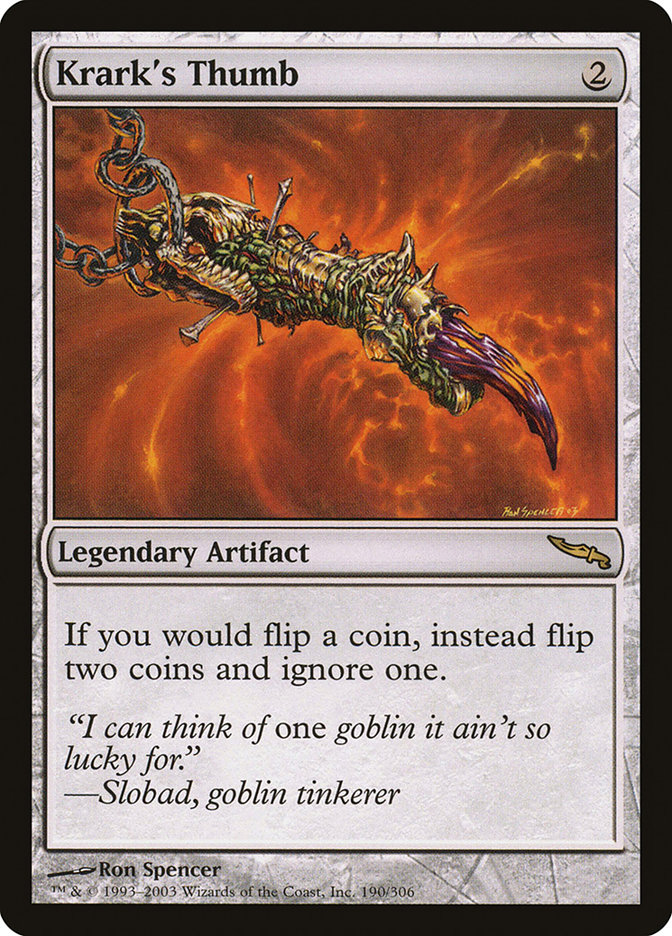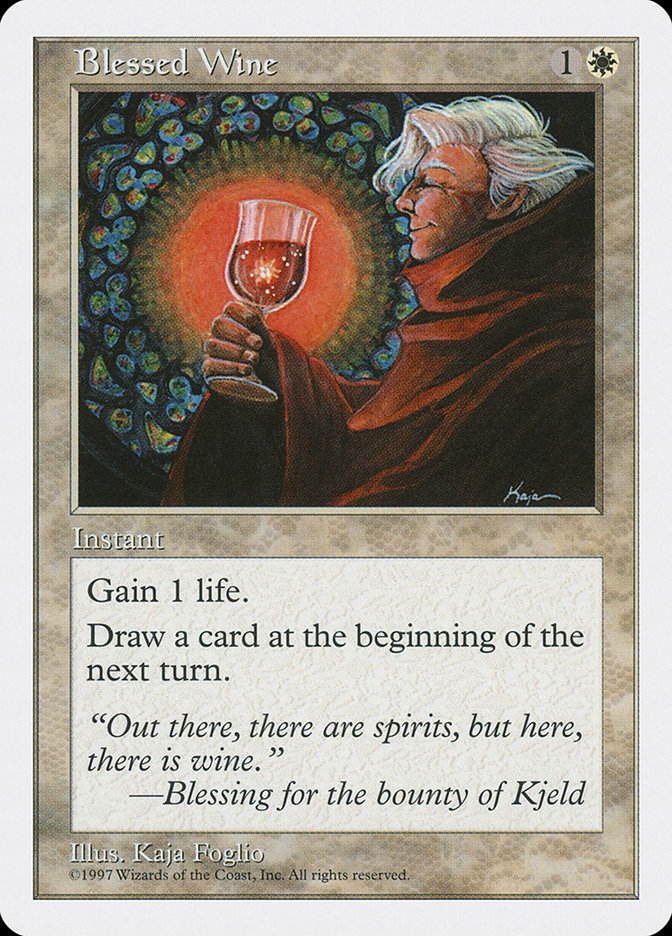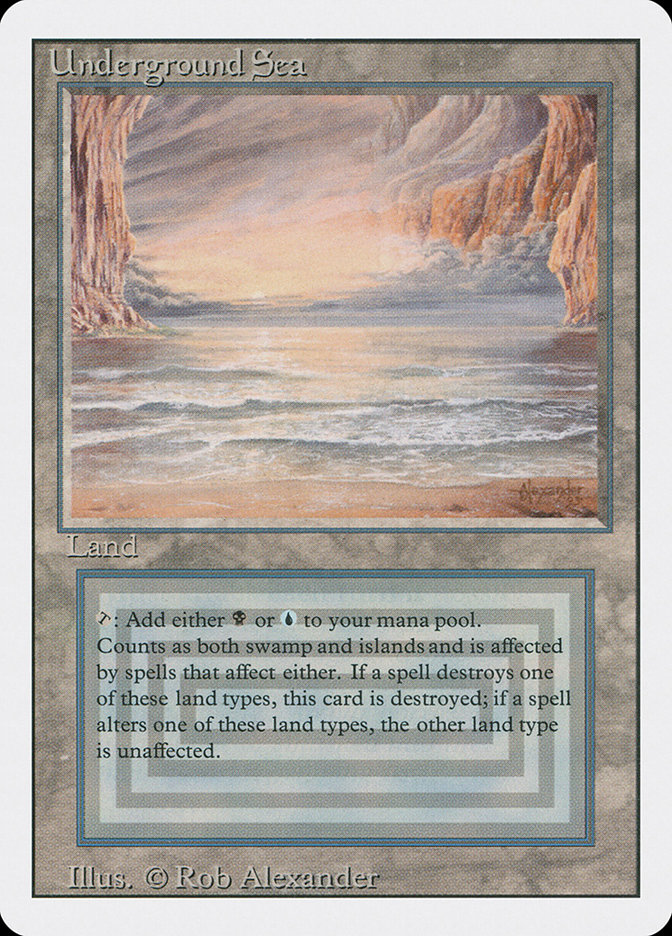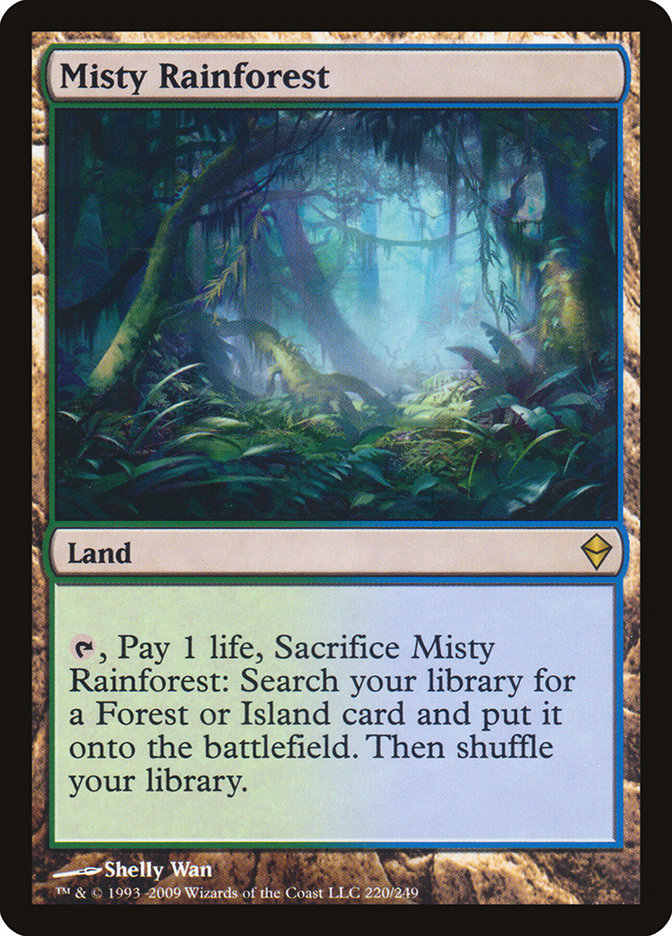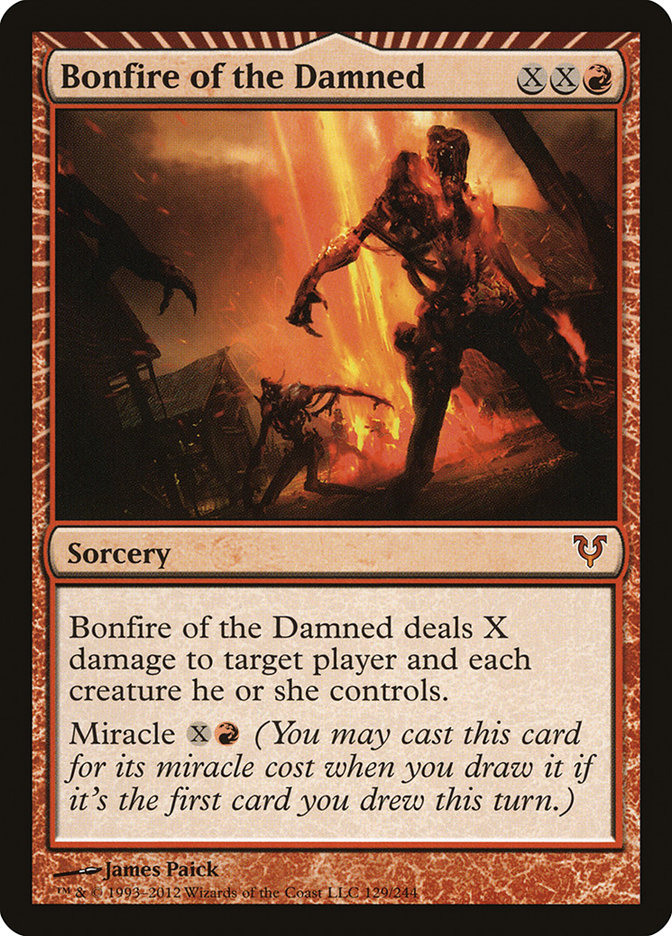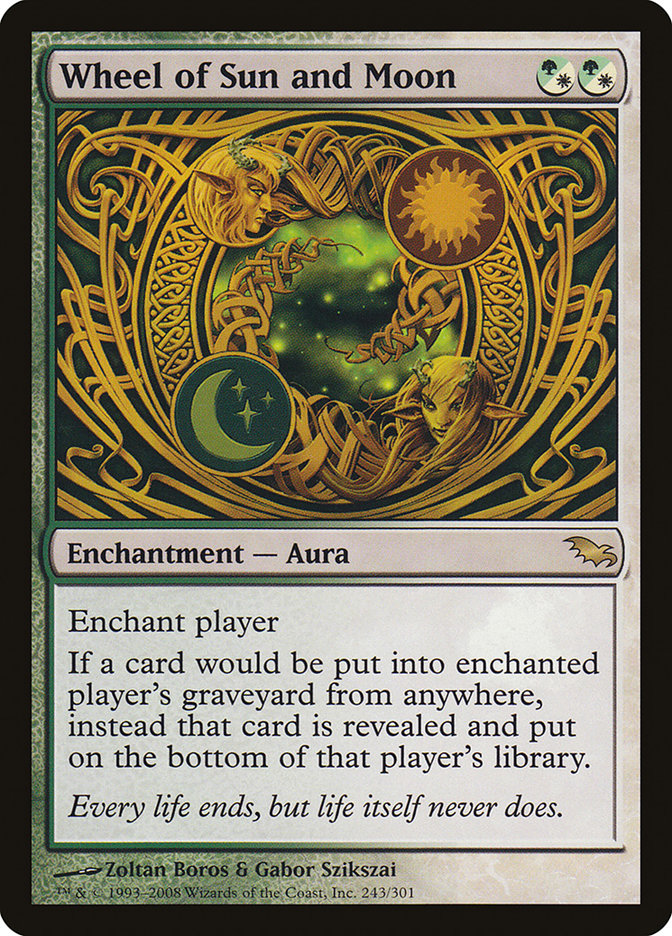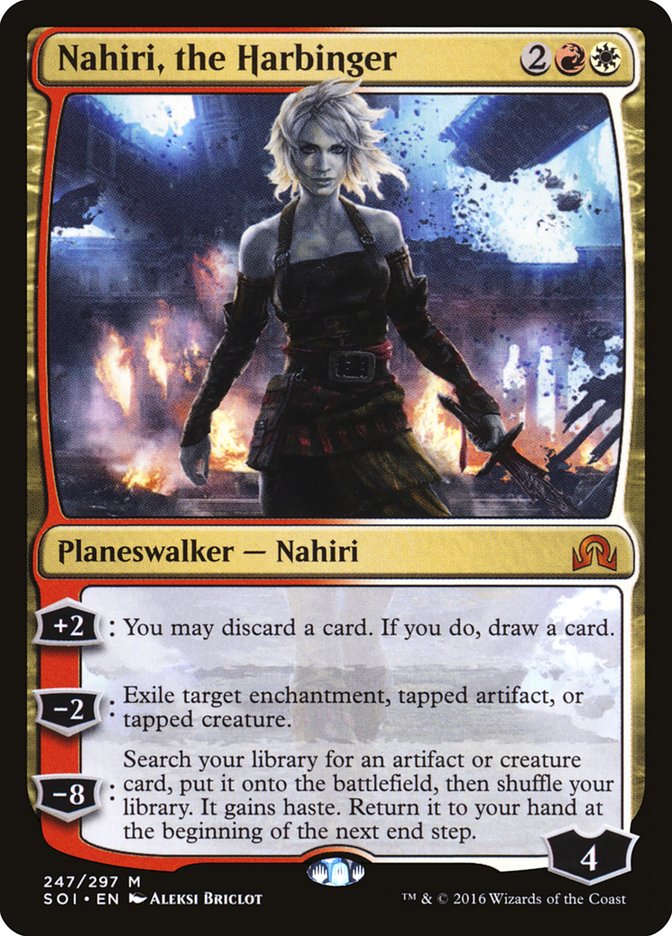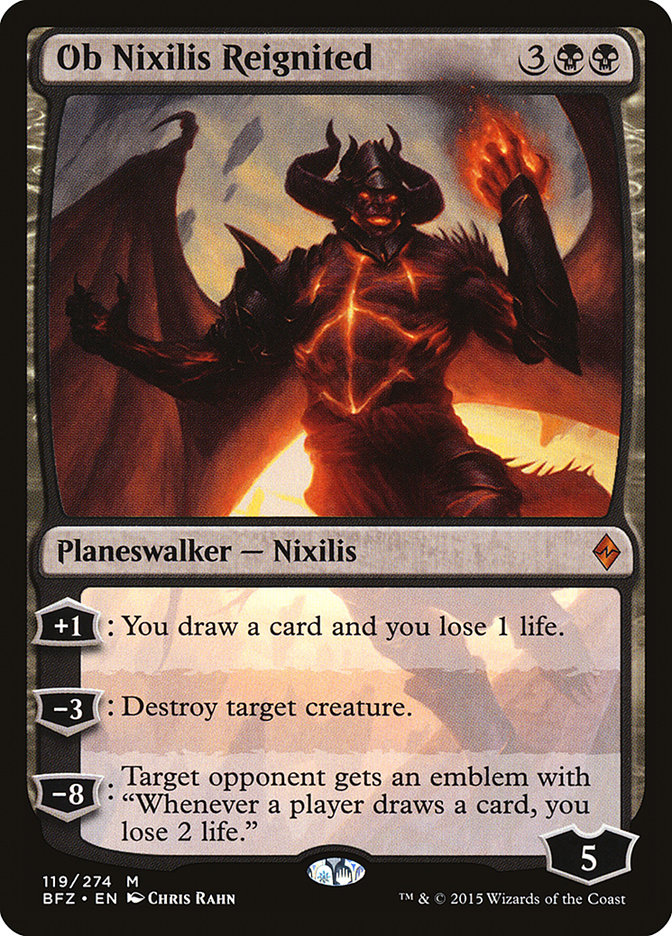 so many great ones out there—but if pressed, I’ll go with Limited Resources. Draft is my favorite format, and Luis Scott-Vargas and Marshall Sutcliffe do a great job combining nuts-and-bolts insight on specific cards with big-picture advice on how to improve your overall game.
so many great ones out there—but if pressed, I’ll go with Limited Resources. Draft is my favorite format, and Luis Scott-Vargas and Marshall Sutcliffe do a great job combining nuts-and-bolts insight on specific cards with big-picture advice on how to improve your overall game.
A few weeks ago, Limited Resources did an entire show about heuristics, mental shortcuts you can use to improve your decision-making. It was an all-time great episode of Limited Resources, and it got me thinking about how often I use heuristics in my own life. That’s when it hit me: heuristics are a large part of how I approach Magic finance, but I’ve never written about them.
So, with apologies and credit to Luis Scott-Vargas and Marshall, who did all the hard work, here we go: my heuristic-based approach to Magic finance.
What are Heuristics?
Heuristics are logical rules that are true enough to be useful. In the absence of additional evidence, you are better off using a heuristic than not.
“True enough to be useful” seems like a vague statement, so let’s unpack it a little. By their nature, heuristics can’t be true 100% of the time; those are what we in the business call “facts.” I wish I could be more specific and tell you that all heuristics have to be true at least 51% of the time or something, but there’s a lot more going on than that.
In a low-stakes situation, a heuristic can be worth following even if it only gives you the slimmest of advantages. For example, you should always choose tails when a coin is flipped because the “heads” side usually weighs a little more. This gives you an advantage on maybe one out of every hundred flips, but there’s no reason not to adhere to the heuristic if you want to gain that slight edge.
In other situations, you might want closer to 100% certainty before adopting a heuristic. For example, a heuristic stating “nuke your rival country in retaliation if this radar screen lights up with incoming missiles” would only be useful if you could prove beyond all doubt that the radar wasn’t prone to malfunctioning, that the radar blips weren’t just 99 red balloons, that the incoming missiles did indeed come from your rival country, that a retaliatory attack would actually save more lives than it took, etc.
Heuristics might seem complicated, but you actually use them every day without thinking about what they actually are. Are you a daily coffee drinker? If so, then you are probably obeying the heuristic “drinking coffee every morning makes me more productive/feel better.” Sure, there will be some days when having that morning coffee is a bad choice—perhaps you are about to go into a long meeting and you won’t be able to use the restroom—but the heuristic will hold true often enough to be useful. The alternative is to spend precious brainpower every morning thinking, “Hmm…should I have coffee today or not?”
It’s also important to remember that heuristics are only worth following in the absence of additional evidence. Let’s say you have a heuristic that says you generally prefer wine to beer. If you go to a dinner party and the host asks you if you’d like a beer or a glass of wine, you’ll ask for the wine and end up happy most of the time. This is a great heuristic, because once you figure it out, you’ll avoid being disappointed by mediocre lagers nearly as much as you currently are. But the heuristic won’t always hold true—if, say, you love barrel-aged stouts and can’t stand cheap wine, there will be times when it will be well worth ignoring the heuristic.
The same is true in Magic finance, which is why I’ll end the discussion of each heuristic with some situations where I think it breaks down. Heuristics are only useful if you’re okay abandoning them when it is correct to do so, a skill that comes with experience.
The fact that they aren’t always true doesn’t mean the heuristics themselves aren’t useful, even for experienced traders and speculators. Anyone who has been in the finance game for a while knows that cascading small decisions can be the difference between major profits and big losses. Sometimes, putting something into words—or even just reading about something you already do in a new way—can help solidify a concept you already knew was important. This is my goal for today.
Ten of My Favorite Magic Finance Heuristics
#1: Get the best card in each trade.
I often end up in a position where I’m looking through someone’s binder, she’s got several of my cards out on the table, I eventually find a couple of things I like, we look up the prices, it turns out that the deal is roughly even…and for some reason, I’m hesitant to pull the trigger. When should you make the deal, and when should you hold off?
All things being equal, you should make the deal if you end up with the best card in the trade and pass if you aren’t. I know “best” is a vague term in theory, but it’s usually easy to identify in practice—there’s almost always going to be one card in the deal that’s worth significantly more, or is the only one that sees play in Modern, or which has been a staple much longer. If you get the best card in an otherwise even deal, it’s rarely wrong to make the trade.
Exceptions: I can think of three big exceptions. First, this heuristic works best when you’re making a pure value trade; if you’re trading for a card you need for a deck, feel free to ignore it. Second, lots of people innately obey this heuristic, so you can use it to gain value if you’re after a small pile of specific low value cards that you think will spike. Third, trading staples for bulk or bulk rares can be among the most lucrative options at the trade table. You just have to make sure you get them at true bulk prices and not at full retail.
#2: Prioritize lands over everything else.
You can follow this heuristic when trading, when buying cards for your next deck, and when deciding what new cards to speculate on. In all these cases, start with the lands first. Get in early, and only sell your lands if you absolutely have to.
This heuristic is rarely wrong. I should have bought more fetchlands at their historic lows, I should have bought more creature-lands before Shadows over Innistrad was released, I should have pre-ordered Westvale Abbey…heck, even Adarkar Wastes had its moment in the sun this year.
Exceptions: If you love quick flips or big bargains, lands tend to be a little too stable to be interesting. They rarely fly under the radar for long, so this rule is better for people who play a lot of Standard and need the cards for their own personal collection. It can also be correct to sell Standard-legal lands that aren’t good enough for Eternal play at the height of their playability: see the Theros block Temples, some of which dropped in price by more than 90%. Otherwise, though, it’s pretty rock solid.
#3: When speculating on bulk rares over the long haul, focus on non-creature spells.
Good creatures are obviously good; they’re great in Standard and the Eternal community discovers them right away. Cards like Nephalia Moondrakes are never going to be good in Modern. They’re balanced for Limited/Casual play and aren’t even going to make a peep in Standard, much less anything with an even higher barrier of entry.
Spells and enchantments, meanwhile, are often incredibly niche. They’re powerful assuming a very rigid and specific set of circumstances, which often don’t come together until years after being printed, like Heartless Summoning, Hive Mind, etc. As a current example, Harness the Storm is awful…unless you have a lot of cheap/free spells in your hand and copies of those same spells in your graveyard. You want to fill your bulk box with cards that have a chance to be great someday if the right set of circumstances come to pass. Creatures rarely fit this bill.
Exceptions: Death’s Shadow is the exact sort of creature that defies this heuristic by being very good in exactly one specific way. Some expensive creatures, giant mythic Dragons and such, are often great casual specs as well. Meanwhile, spells like Burn from Within have next to no chance to see significant Casual or Modern play in the future. Basically, what you want are unique effects and combo pieces. These just tend to show up more often on non-creature spells.
#4: Move toward liquidity.
You should value cash far higher than cards. Cash is liquid; you can spend it on whatever you like, wherever you’d like, which is (sadly) not currently true with Magic cards. Concurrently, you should always value high-end staples that everyone needs (fetchlands, Archangel Avacyn) higher than niche spells that only a few people want. And you should value those higher than obscure foils and ephemera.
In a world where people are dead-set on getting even value on their trades, liquidity is undervalued. The closer you are to cash in the liquidity chain, the easier it becomes to maneuver. This is a more general way to view the “always get the best card in a trade” heuristic, but it bears repeating.
Exceptions: You can often get more than retail for weird foils and ephemera as long as you have a specific buyer or trade partner ready; this is just a matter of knowing your particular market well. And again, this rule doesn’t apply if you’re acquiring cards you need for a personal deck.
#5: Value your time more.
If you’re in the Magic finance game at all, you probably don’t value your time enough. Seriously, between drives to events, half-hour “trades” that go nowhere, bulk picking, listing, shipping, and everything else, it’s very hard to make even minimum wage trading and speculating on cards.
Magic cards are awesome, though, so I get why you haven’t given up the game; I haven’t, either. But that doesn’t mean you can’t value your time a little more than you currently do. It probably isn’t worth picking through that bulk for the fourth time, or inventorying every bulk rare in your collection, or making spreadsheets for collections you may or may not buy, or speculating on that low-end rare that might net you a $0.10 profit per transaction. When in doubt, spend less time on all of this.
It’s also worth throwing in the extra dollar card or two to finish that trade. If the deal was worth spending twenty minutes trying to work out, it’s worth a theoretical dollar to get it done. Otherwise, what were you doing spending all your time on that trade in the first place?
Exceptions: Card sorting can be genuinely pleasurable; if that’s what you love doing in your spare time, don’t let me make you feel guilty for doing it. This is also not an excuse to be mean or rush people during trades and sales. Magic finance can be a genuinely fun experience and a great way to meet new people. It’s important not to lose the, uh, magic just because you want to account for your time a little bit better.
#6: Don’t go too overboard when you pre-order cards.
The vast majority of cards drop between the day they go up for pre-order and their second week of Standard legality. Most people (yes, including you) are not very good at card evaluation, and we all tend to overrate cool, new spells and creatures. I consider myself a passable card evaluator, and most of my set reviews contain miss after miss after miss.
People are also really good at remembering how cheap some future staples were at the start of the pre-order period and horrible at remembering how expensive sole future flops were at the start of the pre-order period.
Exceptions: Everyone has specific knowledge that can help them out here. If you’re a Legacy Storm player and you just know that a new card is going to re-define your deck, feel free to go deep on it. If you’re part of a competitive testing group and you think you’ve got the secret to unlocking Standard, go ahead and buy a half-dozen playsets.
Ditto if advice from your favorite pro about a specific card directly contradicts the market or common knowledge, especially when it comes to cards that are hard to evaluate in a vacuum. Patrick Chapin was way ahead of the pack on Miracles, for example. What you should avoid are the “Whoa, that card looks nuts! I should order four of them for $30 each!” moments based on gut reactions. Your gut reaction should be a lot closer to “I don’t pre-order cards.”
#7: Avoid making snap buys on undiscovered Standard cards.
To me, this is the most tempting scenario in Magic finance.
I’m at a large event, or I’m watching a stream early on Day 1, or I get an insider tip from a friend of a friend, or a pro I respect writes an article all about a sweet new combo piece. I start drooling about the future potential of some $2 rare or $3 mythic, and before you know it, I’ve sunk at least a hundred bucks into Nivmagus Elemental or Crush of Tentacles or Daybreak Ranger or See the Unwritten or any one of a dozen other bad buys I’ve made over the years.
This will go right enough of the time (Boros Reckoner, Pyromancer’s Goggles) to never not be tempting. But you’re much better off waiting a little longer—even if the acquisition price is a little higher—instead of deep on cards that will end up being a giant money sink.
Exceptions: Again, there will be cases where buying cards like these is clearly correct. Boros Reckoner was everywhere the first week it was legal, so it was a clear win for anyone walking the tables at that SCG Tour® Event. Pyromancer’s Goggles was a bulk mythic that did absurd work on camera during the first week of a new format, and thus was a very low-risk buy. There are also some brewers (Saffron Olive right now, Conley Woods and Travis Woo in the past) whose budget decks/bulk rare builds almost always generate enough interest to create a profit.
In general, though, you want to wait for at least a little proof before buying in. Buying in on rumor alone is a bad call.
#8: Buy undiscovered Legacy and Modern cards at the first whiff of excitement.
This is the opposite of my advice from the last section. Unlike in Standard, where cards need a large boost in interest for the price to go up, it doesn’t take much for an Eternal card to spike. The reward is much higher with these cards, too; look at Wheel of Sun and Moon, which jumped to $20 overnight mostly because some finance guys started talking about it on Reddit. I’ve bought random Modern cards based on forum threads, information from dubious sources, and play in early-round videos starring decks that went on to horrible losses. I’ve rarely lost money on any of these buys.
Exceptions: There are limits to this rule. Some spikes are so clearly based on nothing that you should probably avoid buying in, especially if a card is already expensive due to Casual play or some random common that no one has ever actually played in a competitive deck. Don’t be stupid about this, obviously, but if you’re on the fence, buying in is generally correct.
#9: If you can buy a collection, buy that collection.
I didn’t think I’d need to put this as a heuristic since it seems so obvious to me, but I’ve spoken to enough people who are on the fence about these sorts of buys that I felt it was necessary to include.
Everyone who has played the game long enough has opportunities to buy collections. Friends that quit, family acquaintances who used to play, lapsed co-workers, Facebook groups, Craigslist, etc. These collections can range from under a hundred dollars in value to many thousands of dollars.
Obviously you can’t buy every collection (unless you have a lot of cash on hand), but many players simply don’t want to do the math to make an offer, end up fretting about the large cash outlay, or don’t want to take on that many cards…but then they keep buying boxes for $100 a pop and cracking all the packs between rounds at FNM.
That’s fine, but don’t forget that buying a collection at a discounted rate is a better deal than literally everything else you do in Magic. It’s going to give you more long-term value than speculation, trading, and prize-winning combined. When these opportunities come up, take them.
Exceptions: First of all, there’s always one person who quits Magic every six months and then gets angry at whatever store he sold his cards to at a third of current retail. It’s okay if you want to avoid dealing with them. Ditto all the other unreasonable players who think they can sell their collection—commons included—at 90% of retail. It’s rarely worth your time (see #5) to explain the entire Magic economy to these people.
#10: Bet on situations over fundamentals.
Let’s consider two specs side by side. The first is a solid six out of ten on the power scale, but it’s got an obvious slot in two top decks, R/G Aggro and Burn, say. The second is a nine out of ten, but it’s a gold card in a color combination that isn’t being obviously supported right now.
Even though the second card is obviously better, I’d rather have shares of the first card. I know it’ll have multiple guaranteed homes, so demand will be there from the start. The second card might end up being a format staple…or it might end up being Olivia, Mobilized for War in the weeks after the Shadows over Innistrad release.
Exceptions: These second cards, powerful but without a home, are the best places to look for specs during spoiler season. Sometimes, powerful but overlooked cards do eventually break through…it just takes a while, and it can lose you an awful lot of money in the meantime.
What are your personal Magic finance heuristics? Hit me up in the comments section!
This Week’s Trends
I called Nahiri, the Harbinger as a great Standard spec following the last Pro Tour, but never in my wildest dreams did I imagine she’d end up as the flagship in what appears to be a Tier 1 Modern deck. Nahiri is sold out at $50 right now, and her immediate future will largely depend on how Grand Prix Los Angeles shook out over the weekend—those results are still in my future, so I’ll have to hedge a little here. If a Nahiri deck made Top 8 or even if enough of them performed well enough on camera, I could see her spike to $60-$70 before dropping off a bit as more people open Shadows packs. If not, then I expect $50 will be her short-term peak as she gradually falls off toward $35 or$40. Regardless, it is very hard for a card in a current set to maintain a $50+ price tag without dominating Standard via multiple avenues like Jace, Vryn’s Prodigy did last season.
Nahiri’s long-term future depends on how the Modern metagame evolves to combat her. Early returns are impressive, but many promising strategies in Modern have folded to sideboard hate or minor format adjustments. If Nahiri is here for the long haul, she’s not going below $35 for a very long time.
There’s probably some quick flip money to be made on potential Nahiri hate targets, too. Grafdigger’s Cage, probably the best anti-Nahiri card since it’s live against a large part of the current meta, is already up to $10 and could go even higher. I’ve seen some talk about more narrow answers (Bribery? Zealous Conscripts?) but Modern sideboards have to deal with so many varied threats that it’s difficult to devote any slots to a single matchup without any splash-over potential. I’d be wary of these cards as anything more than buyout-driven spikes.
Wizards of the Coast made some major announcements about future Magic products this week, too, and it might be a while before we know what each of them will actually end up meaning. Let’s go one at a time:
1) The fall set will be called Kaladesh, and it will take place on Chandra’s home plane. Based on everything we know about the place so far and the fact that the winter set is named Aether Revolt, expect plenty of artifacts and artifact-related shenanigans. Any cards from BfZ block or Shadows block that currently deal with artifacts are worth a second or third look. People also bought out Steamflogger Boss again, hoping that it’s finally time for Riggers and Contraptions, but I can’t imagine this will work out well for them. Can you really see WotC printing Riggers and Contraptions in such a way that Steamflogger Boss is both good and isn’t reprinted? My hope: a Steamflogger Boss plant in Eternal Masters that hypes everyone up all summer long.
2) Commander 2016 will have four-color commanders! People have been after these for years, so expect interest to be very high among a very small subset of long-time casual players. You can spec on the Nephilim if you want, but none of them are great and they’re all likely reprints for the set regardless. Foils will probably trade well, but they’re already a bit too expensive for my tastes.
3) The next Duel Deck will be Nissa vs. Ob Nixilis. I assume we’ll be getting the Battle for Zendikar version of both planeswalkers, so make sure you sell your copies at some point in the next three months. They’ll both be solid Standard cards in the meantime, though, so there’s no need to panic-sell or anything. The value probably won’t dip at all until a couple weeks before the September 2 release date.
4) They’re printing a Planechase anthology, which makes my collecting of all the planes seem a little silly now. It’s going to MSRP for $150, so the appeal will be very limited, but it should keep the prices of these things from every going truly crazy. You get a lot for your money, though – Shardless Agent, Maelstrom Wanderer, Ghostly Prison, Cabal Coffers, Kor Spiritdancer, Sakashima’s Student, and Baleful Strix are probably the best. It’s also worth noting that you get all 86 planes, which includes the promo planes like Tazeem. That card is down to just $25 now in anticipation of the set’s release. Overall, I’d expect these cards to all drop a little but probably not more than 10-20%. Most people who buy this box set will be keeping it together as part of their personal collection.
5) WotC is reinventing their Intro Packs with a new product called Planeswalker Decks. There will be two each block with an MSRP of $14.99 and two booster packs inside. Each will have a big, splashy, mana-hungry planeswalker that will be Standard-legal but will not be pushed for Standard playability. It’s possible that WotC will misevaluate this at some point in the future and we’ll end up with a run on a Planeswalker Deck, but I’d imagine they’ll err on the side of extreme caution early on. Don’t worry about these at all right now unless you want to pick one up for your own casual collection.
What’s happening in Standard? Not a ton, as the market (besides Nahiri) continues to fall off a little in the post-Pro Tour culling. Kalitas, Traitor of Ghet; Collected Company; Dragonlord Atarka; Secure the Wastes; and Dragonlord Silumgar are the risers. If you’ve played any Standard at all in the past few weeks, you probably recognize these cards as major pieces of the format’s top decks.
Modern, meanwhile, is fairly stagnant other than the cards in the Jeskai deck and answers to it like Grafdigger’s Cage. I’d certainly love to own a set of Snapcaster Mages right about now; it’s unlikely to be in Eternal Masters, and it’s a four-of in many of the Nahiri builds.

